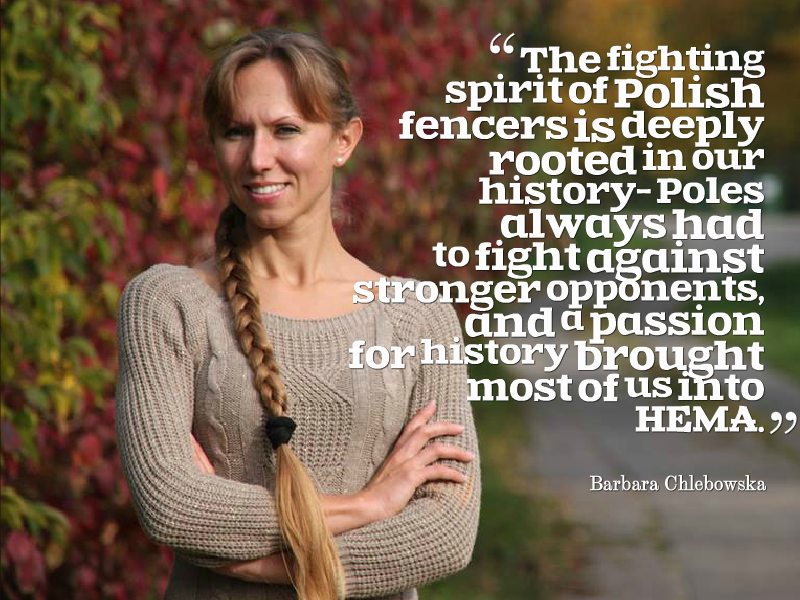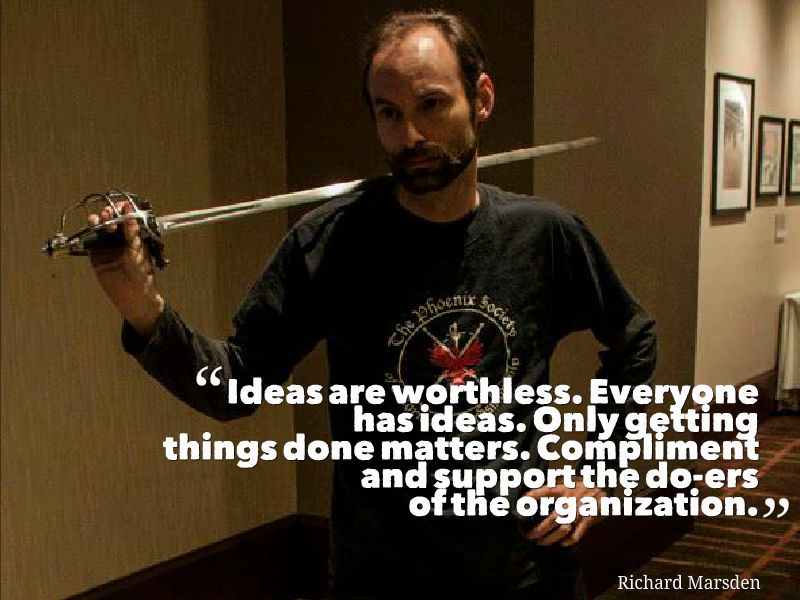Original Post: 13 Apr 2014
Four presidents, two continents, one HEMA.
Interviews by Fran Terminiello
Barbara Cheblowska – President of FEDER, Poland

How did you first become involved in HEMA?
My brother Szymon was one of the best reenactment tournament fighters in Poland. I admired his fighting and also wanted to participate but this type of fencing was too difficult for me due to my physique. Szymon found out about Fechtschule Gdansk and I started training HEMA in August 2007.
What was your path to presidency, what is the process and how long will you hold office?
Since 2007 I have trained longsword intensively. When I first started I was the only female in Poland that fought in tournaments, so I was easily recognisable. I joined SMDF, which is the oldest HEMA event in Poland (and the only one at the time). After this I started producing kit for DESWu, and in May 2013 I was chosen as president of FEDER.
How does FEDER operate, when was it formed and what are its goals?
FEDER was created in Feb 2008 . I have been a member since the beginning. Our main goals are promoting and helping HEMA to grow, networking with other fencing associations, ref training, creating fencer ranking and events rules. Every group in Poland can ask FEDER for patronage or financing.
Poland has a reputation for being a strong fighting nation. What is it about HEMA in Poland that makes it unique?
The fighting spirit of Polish fencers is deeply rooted in our history- Poles always had to fight against stronger opponents, and a passion for history brought most of us into HEMA. In the Polish mentality the picture of a strong, honourable fighter – an individualist who never gives up, is strongly rooted. Besides it is a very difficult and expensive sport. If someone went all the way from basic guards through getting expensive kit up to tournament level it means the person if very strong physically and mentally and always gives 100%. We also have excellent instructors who give a lot of time to their students and fight analysis.
What has been the biggest challenge to you as President so far?
It’s hard to say because as President you need to give a lot attention to many different things. But I think that the greatest challenges for me and the FEDER management team were participating in the creation of IFHEMA and the unprecedented case of banning of Jan Chodkiewicz from all events organised by the Swedish HEMA Federation. It’s still an ongoing case and FEDER is not agreeing with this decision and waiting for the Swedes to reply. I hope that a positive outcome of this case will be the creation of standards that will help to avoid such misunderstandings in future.
Richard Marsden – President of the HEMA Alliance, USA

How did you first become involved in HEMA?
I was a member of the Loyal Order of the Sword run by Greg Hinchcliff from 1994 to about 2008. Greg was a wonderful mentor! We’re still in touch and he’s happy to see where I’ve gone.
John Patterson and I formed our own organization which from around 2008 on developed into the Phoenix Society of Historical Swordsmanship. At the High School I teach at we formed the Peoria Historical Fencing Club for the kids. Our organization has been steadily growing and is designed to quickly create competent Historical Martial Artists and leaders.
In 2011 I joined the HEMA Alliance after finding that I liked the idea of a service organization whose purpose was to facilitate the various clubs and schools in the country.
How did you become the president, what is the process and how long will you hold office?
The HEMA Alliance members elect their unpaid and entirely volunteer Governing Council (GC) and President to serve from August to August of a given year. After serving a year as General Secretary under President Mayshar in 2012, and heading the Polish Saber project, I was elected President in 2013.
A President serves for a year, but can be re-elected with term limits currently set at five years. I parade around as a Tyrant, which is a part of the humor of our organization. In my year as President, the GC and our Curriculum Council (CC) under Lee Smith and now ‘Tiger’ Mike Edelson have accomplished quite a bit. One of my goals as President was to see things accomplished. Great ideas are meaningless, because everyone has great ideas. Making them a reality is what counts- and that has been my focus. We have organized a fund-raiser for Wiktenauer (A HEMA Alliance project under Michael Chidester), we are reorganizing how we track membership, we have increased member-benefits in the form of discounts from both events and vendors, we have created a policy where we can sponsor events, the CC has put forth an instructor certification program and also critiques videos. We have more in the works- especially in the behind-the-scenes nuts and bolts of the organization, from insurance to budgeting to organization of material and all things in-between.
How does the HEMA Alliance operate, when was it formed and what are its goals?
The HEMA Alliance was created by ‘Papa’ Jake Norwood and several others to be a non-profit organization and service provider. The HEMA Alliance’s primary purpose is to provide services for its members and affiliates such as discounts and insurance, and to facilitate the community, through things like our Facebook page and forum as well as our sponsoring and promotion of events.
The Alliance is a Big Tent and not a Super-Club. The Alliance wants to support clubs, schools, events and believes its members should be free to study how they wish within the bounds of our bylaws and insurance. We strongly promote researchers, fencers, organizers, teachers and students because that is HEMA as a whole.
The Alliance has a board of directors whom watch over the organization as a whole. They leave the operations in the hands of the yearly elected President and Governing Council. The GC picks a Director of the Curriculum Council, whose task it is to operate separately, but in cooperation with the GC to provide members with resources and services.
What is it about HEMA in the United States that makes it unique?
I’d like to think that it is not unique and that wherever we are in the world, we are all trying to bring to life the arts of the masters who came before us.
What advice would you give to the next president of the HEMA Alliance?
I’ve already written an extensive guide on that. However, for some quick advice.
1- Be patient and love all of God(Nature/Odin/Mother Gaia/Great Cthhulu Who Dreams/The Emperor of Mankind)’s creatures. The community is small, full of personality, and balancing personalities, without compromising the Alliance and its mission, is a large part of the service.
2- Ideas are worthless. Everyone has ideas. Only getting things done matters. Compliment and support the do-ers of the organization.
3- Do not reach beyond the scope of the Alliance. Do a few things well, improve on the mission, and do not over-create things that need close management. The Alliance is to provide services and interference with the way its members practice should be limited to meeting our legal needs (cash and insurance).
4- Be visible. The community likes to have a face, so they can cheer that person on, or yell at them.
